If you run an online business, an understanding of organic traffic, how it works and the context it lives is integral to your ability to survive and thrive online.
To get SEO tips, the vast majority of people read blog posts from the same handful of sites.
The problem with this is most SEO tutorials online are dated (so they don’t work anymore), situational (won’t generalize to your site), overly tactical (easy to get in the weeds), and/or are written by… non SEOs (copywriters).
The SEO game has changed.
The new SEO
When we talk about SEO now, we are exclusively talking about Google. It used to be widely believed that Google had about 65% market share, when in fact its above 90%.
It’s not infrequent to see your Google Analytics profile showing 50% to 70% of your web traffic coming from “google / organic” for Source/Medium.
In addition, Google has been siphoning off more of that search traffic for itself, as I mentioned before in Why your Google traffic has been going down for years.
Google’s goal for its search results
Pretty much all of Google’s changes boil down to two things: making money (increasing shareholder wealth as Google is a publicly traded company) and improving the quality of its search product (serving the best results for users).
As long as Google can make more money AND serve better results to users, it will optimize for that. If it can optimize for one while not hurting the other, it will do that. If it can only optimize for one, it will try to make more money and do things to limit any downside.
This isn’t a complaint, its an observation, and one with far-reaching implications for your business.
As they say, “a leopard never changes its spots.” And you can always trust that Google will do things in its own best interest.
As an SEO, we are in constant flux, constantly reacting to the latest updates, and dealing with FUD (fear, uncertainty, and doubt).
So in a way, I find the idea that Google will always have the same two above goals to be a reassuring constant.
So how are Google’s approaches to these goals changing and what’s it mean for you?
In-SERP SEO
The old way of doing SEO was simpler. When you comb the web for SEO tips, you’ll see a lot of vestiges of this simpler time.
When you follow those tutorials, you’re optimizing for the “Before” when what we have now is the “After.”
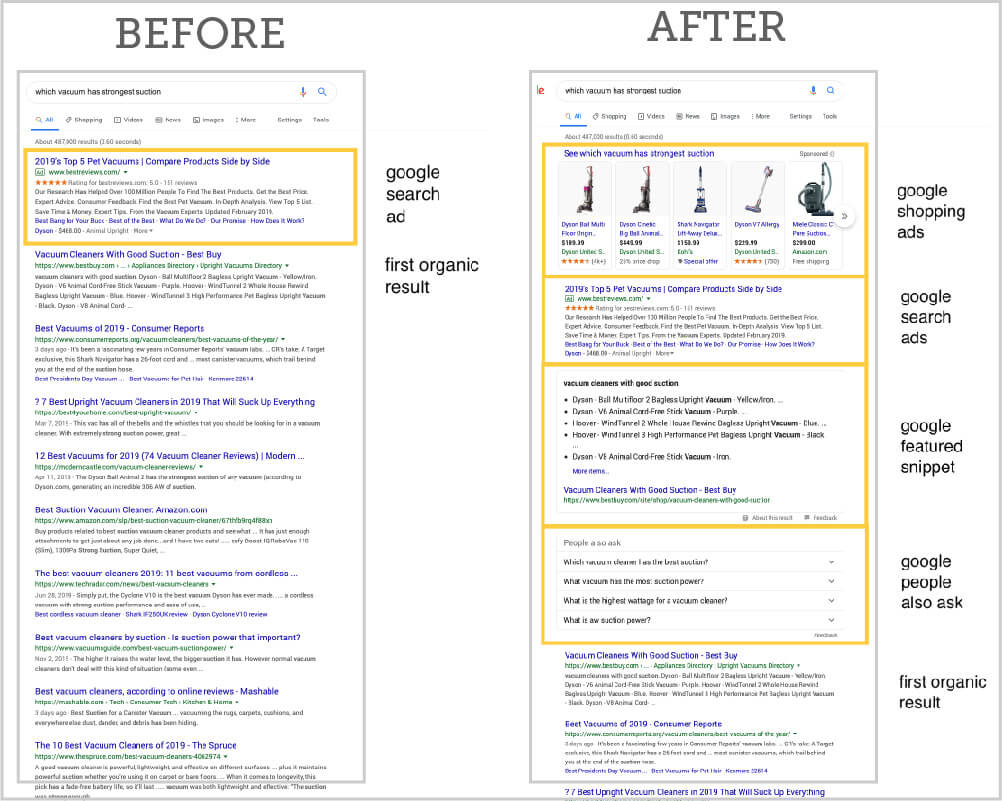
In the before, you’d see a keyword with high search volume as reported by a tool, do some quick math for traffic estimates (1st position = 20% to 30% of volume) and conversions (traffic x conversion rate = $$$), lick your chops, and get on your way working on that ranking.
Now you first have to think about the anatomy of those pages.
Enter SERP Feature Analysis
As a reminder, SERP is an acronym for search engine results page.
In the past, you only had to consider ads on a SERP and the occasional local map 3 (or 7) pack.
It was well worth spending time to rank for a “good keyword,” as long as the SERP showed good search volume.
But now the definition of a good keyword has changed. In determining good, we now have to say, “good for what?”
Is it good if there is a row of image thumbnails? Is that an opportunity or a threat? It depends.
Ahrefs and SEMRush (two commonly used SEO tools) do a good job of highlighting “SERP Features” that can take over a results page. They also both estimate click potential for you accounting for the effect of those features taking over the SERPs.
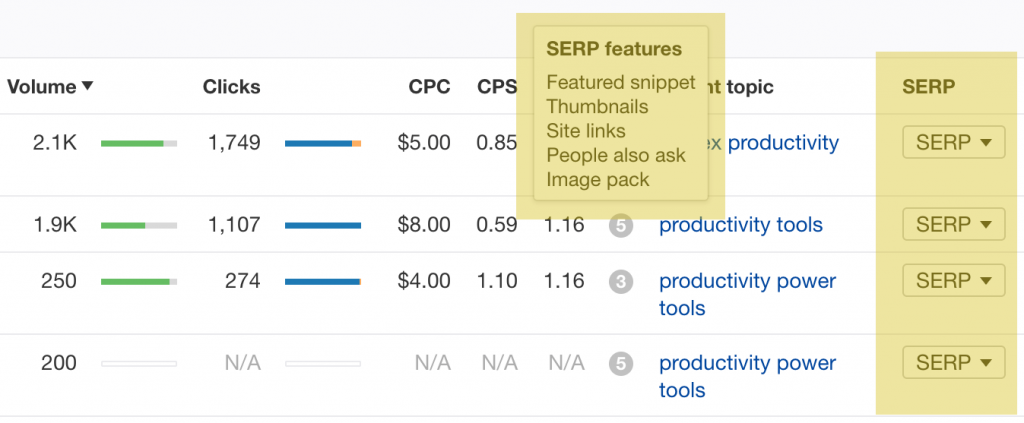
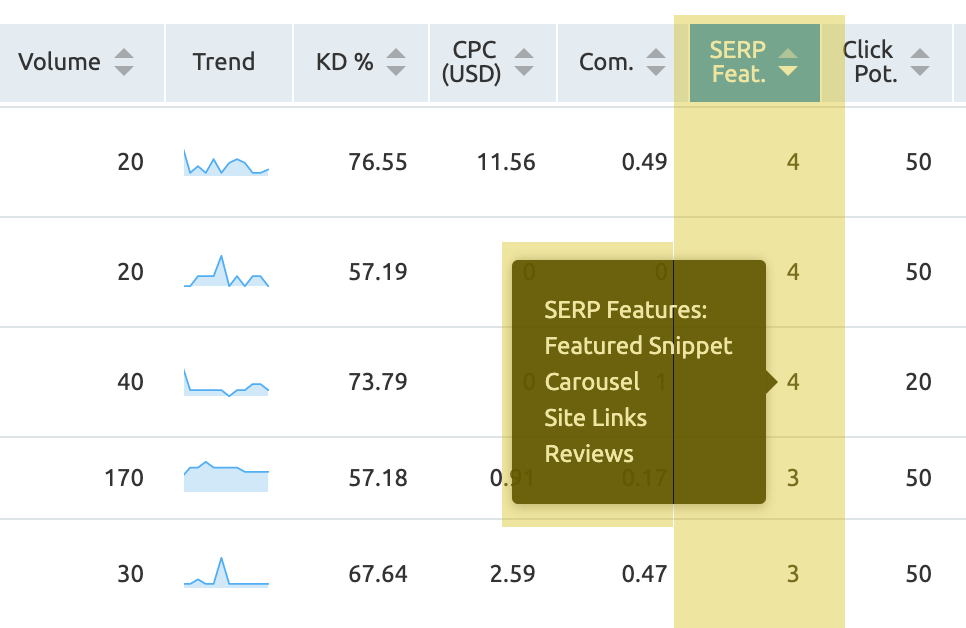
Any keyword research approach that doesn’t account for this could lead to you spend months of energy getting somewhere that has become irrelevant from a traffic standpoint.
A new dimension of SEO has popped up to account for these changes.
For example, in accounting for a series of keyword phrases that show video cards in the results, considering the value of those video card positions means it may be time to consider a video strategy that includes Youtube embeds.
From “filling the buckets” to “filling the features”
This isn’t too different than the approach of “filling the buckets” that used to apply much more when it was all about the organic results.
In the past, you’d look at a SERP and see results from Youtube, Digg, Slideshare, and other properties allowing UGC (user-generated content).
That meant you could do a talk, add the video to Youtube, add the slides to Slideshare and Scribd, maybe add the audio to something like Soundcloud, and then share it on social bookmarking sites like Digg.
Then you could do some pretty barebones “SEO” linking to those pages and take over that search results page.
I’m sure there are hundreds of articles purporting this approach. And hundreds of thousands of sites still applying them.
In many cases they still have some merit, but they’re no longer a gimme or necessarily a best use of time.
The new SEO as adapting but not too quickly
A bad habit SEOs have is not changing their approach with the times. But a worse habit is blindly adapting to every change.
When AMP came out (an acronym meaning Accelerated Mobile Pages and Google’s solution to slow mobile sites by streamlining content into a smarter RSS feed type page), a lot of sites jumped at the opportunity for higher mobile rankings even though it meant giving up control over that traffic to a Google property.
The results of blindly jumping to AMP meant not accounting for analytics challenges, losing control over page layout, which often harmed user experiences, and traffic you did get becoming more fickle.
We now have better solutions for self-hosting AMP, hand-coding to improve user experience, getting Google to respect canonicals, etc., but for you, with limited resources, its potentially a distraction from higher value activities.
Similarly, now with in-SERP SEO, there is a race to optimizing for these snippets without consideration of whether or not its worthwhile.
And for some snippets, people are already seeing adverse affects on traffic:
In the below, and mini-virally shared around the SEO community, Lily Ray tweeted about adding FAQ schema to her post (adding schema to your content signals meta data to Google which in turn affects likelihood of your content showing in featured snippets).
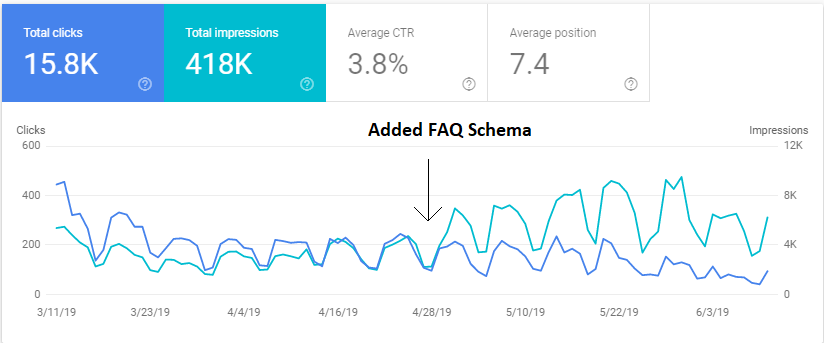
This increased impressions (green line) on her post but correlated with a decrease in clicks (blue line).
The default thinking right now is that having your content show up in a featured snippet is better than having a competitor’s content show up. But as everyone is fighting for less and less scraps at a certain point it makes more sense to look up and around for activities that provide higher ROI than giving G your content so users are less likely to click to your site.
The takeaway? Your content strategy around schema and doing on-SERP SEO should be careful and strategic.
Onward!
To compete in the new SERPs, its also worthwhile to understand the basic types of user search intent (types of keyword phrases), what satisfies that search intent, and what Google’s goal is for different types of queries and how different topics are treated.
Common types of search intent
Let’s take a quick detour into search intent. This is the traditional way we sort and prioritized keyword phrases as SEO.
You’ll see this a lot of places, but here are the most basic types:
- informational (want to know something/learn an answer)
- navigational (want to go somewhere specific, like a favorite news site)
- commercial (investigating purchasing options)
- transactional (make a planned purchase, getting more paper towels)
In the above before-after example the keyword was “which vacuum has strongest suction.” The intent there would be split, maybe 30:70 between informational intent and commercial investigation intent.
In the past (and still for a lot of SEOs), this is how they run projections and inform content strategy.
The “search intent user journey”
If you string the types of searches together, you can get a model for how users use search to make purchasing decisions from start to finish. An example:
- “is nailbiting a bad habit?” (informational)
- “how do i stop nailbiting” (informational – commercial investigation ready)
- “nailbiting products” (commercial investigation)
- “best nailbiting nailpolish” (commercial investigation – transactional ready)
- “buy no bite nailpolish”(transactional)
This is still a useful model in thinking about keyword research. But now instead of informing your organic content strategy with tasty content for the user like this:
- post on “what is nail biting?”
- post on “10 ways to never bite your nails again”
- post on “top nail biting products 2019”
- post on “no-bite nailpolish review”
- post on “how to stop nail biting for good free e-course”
- write 3 day autoresponder info product launch sequence
Now getting in front of users in that same user journey requires 3 to 10x effort, with first few steps looking more like this:
- “what is nail biting” three pronged approach:
- create and optimize FAQs type post on nail biting around “People also ask” featured snippet
- reach out to school newspaper ranking third to share research with hopes of a mention
- consider creating nailbiting product kit with guide reselling no-bite on Amazon to show up in Google Shopping feature
- consider Google Search Ads ad for free guide lead magnet
- get FAQs post reviewed by an MD, cite MD reviewed it, list at least 5 sources on post
- list post two pronged approach:
- “10 ways” video posted to Youtube
- optimize post for knowledge box snippet
- product guide three pronged approach:
- biz dev with competitors, highlighting their products
- consider outreach to researchers for quotes, reference their research as sources
- rank products based on credibility as determined by authorities
- have respected journalist “write” the guide, make sure journalist’s byline includes their credibility to write such a guide
At some point, you are priced out of selling a nail biting info product with “organic” SEO. But in other ways, you can now “shortcut” your way to a higher ranking, potentially cutting months of effort out to test a top of funnel content strategy.
Understanding Google’s goals behind different types of results
Let’s take a look at some specific properties on search results pages and the goals behind them. Understanding where Google is coming from will inform the risk profile for any approach you may be considering.
What ads in search results solve for
Google Search Ads (and Google Shopping Ads) solve for commercial queries. The goal is to increase the cost-per-click on ads and get users to click on those ads as much as possible.
This is Google’s primary monetization strategy.
Over time Google makes changes to optimize for ad clicks.
They do this by rolling out ad structure updates to make ads more prominent like:
- removing ads from the sidebar in favor of above and below organic results
- giving each ad more title characters, lines, spacing
- making the word “ad” that notifies users that ads are ads less prominent
- pushing organic content so far down the page
Other updates targeted at increasing ad revenue include things you might not think about.
One example is Google Suggest. When that was rolled out the goal was to funnel you to specific results pages, driving traffic to those pages up, and therein bids on ad clicks from advertisers. Of course it also helped with user experience, no one was complaining that they could now see how other searched around topics or hit “down” to select instead of continue typing out a query.
Similarly, you could argue that “people also ask,” and “people also search” type knowledge boxes are allowing Google more fine-tune control over nudging users where they want them to go.
Another indirect way they drive up ad clicks is by keeping you on the search results pages and getting you to click less and less through to other websites. More on that below.
What local results solve for
You may think local doesn’t matter to you, but it may be the ace up your sleeve if you’re willing to incorporate an offline component to your list-building strategy. It’s also just worth understanding what local businesses are up against.
Local search results mostly solve for navigational and transactional queries.
With local, imagine a user has already decided they want pizza from Papa Johns, Google doesn’t own a Papa Johns, it would be a bad experience to not send them to Papa Johns, so they make it easy to get there.
Local search results also more and more solve for related transactional queries. By building and leveraging partnerships with DoorDash, Open Table, Grub Hub, etc., Google has figured out how to monetize better here.
Anything G can do to grease the wheels for users wanting to buy things leads to more instant gratification. And, by the looks of it, these changes are often well received in the press.
If G can make a buck while doing it then it is worthwhile.
I responded to a frantic comment on Facebook by someone about the new (very large) “Order Delivery” button added without announcement to many restaurants’ knowledge panels. It looks like this:
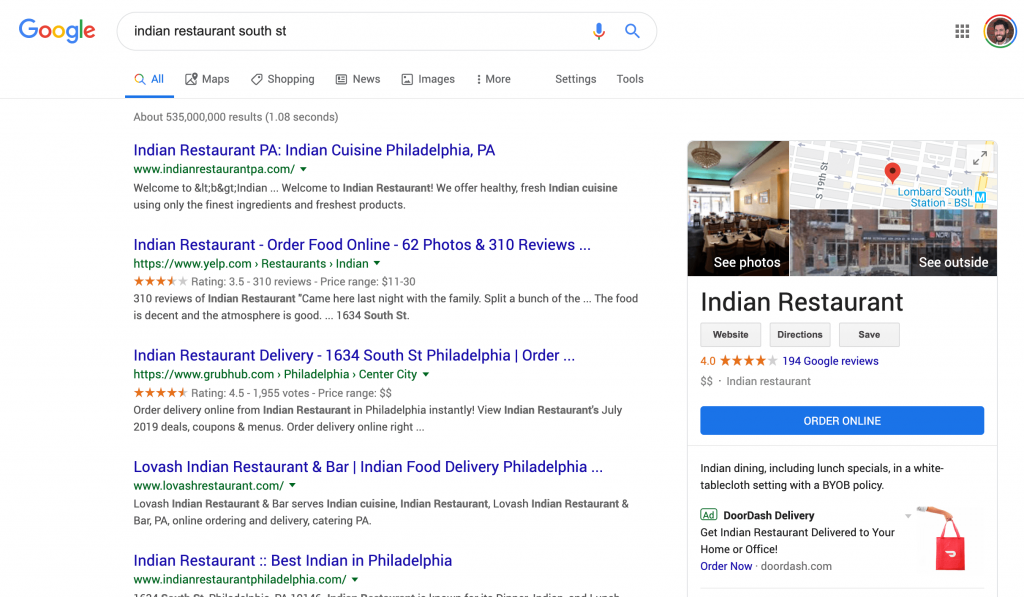
The online order options can eat into up to 30% of the restaurant’s revenue. I’m not sure what kind of margins restaurants have, but this will inevitably be the difference between making a small profit and closing your doors if you don’t want the feature and don’t spend the significant energy to get it removed.
In order to get the button removed, you can’t change a setting in your Google My Business account, you actually have to get the integrated delivery services to remove it, where of course there is no formal documented process to do so. From a forum:
There are currently no quick solutions unfortunately. Similar to the Order links google introduced a few years ago, the only “indirect” solution is to call your ordering providers and ask them to remove it from Google, which they will, of course, acknowledge your request, and then do nothing.
https://www.en.advertisercommunity.com/t5/Basics-for-Business-Owners/New-Order-Online-Button/td-p/1740295
Calling them enough times may elicit an action eventually, but it just seems so tedious.
Another commenter responded that it took hounding the CEO of an integrated online delivery service across social media to get them to remove the button.
Greg Sterling on Search Engine Land put it well:
the move is part of a larger effort by Google to reduce consumer friction, remove steps between discovery and purchase and control more transactions directly, rather than handing them off to (slower) third parties.
Greg Sterling on SEL
This will increasingly mean partnering with and integrating into Google consumer experiences, rather than relying on organic SEO to acquire customers.
If you sell info products online, you might think local doesn’t matter for you. But this is a pattern worth understanding.
It’s one example in a sea of changes aimed at increasing revenue for Google.
In almost all of the above examples (New order delivery button, Google Suggest, “People also ask” and other featured snippets, AMP, increasing ad space on SERPS), we see the same thing: Google is increasing its revenue by keeping users on and getting users to use Google properties as much as possible in the name of making things easier for users.
But alas, in the end, restaurants (and everyone else) will have to increase their prices to account for Google’s cut, they will have to make the hard decision to participate (or not) in “new opportunities” for visibility, market access, (in the most recent example) order delivery app ecosystems, and keep an eye out for new changes they never had to think about before.
When Google maxes out on their ability to earn money off you trying to order from your favorite restaurant, they will consider cutting out delivery service companies, strong arming delivery service companies into better deals, or buying out those companies.
This is not a pizza place problem.
This is an internet monopoly problem.
Once a monopoly reaches 90% market share, the only way to increase shareholder wealth is to squeeze more out of each search and each user.
Let’s move on to organic and then what this all means for you from a cost-benefit standpoint and how to adjust accordingly.
What organic results solve for
Organic search results solve for everything Google either doesn’t care about (yet), doesn’t want the responsibility of providing content for (yet), and hasn’t figured out a way to scrape, remix, and repurpose for their own monetization purposes.
In the past, this has meant favoring more dominant brands. This benefited Google a few ways.
- Big brands spend more on ads
- People trust brands they recognize (the bigger, the more recognition)
- It was a “good enough” signal they could use more and more as a crutch to return “safe” search results, eg. Dyson probably won’t mislead users about how vacuums work, so let’s put them at the top and put howvacuumswork.com lower because its probably just a guy who is really into vacuums.
Smaller brands and sites getting squeezed out of Google’s results is nothing new, but at least, if you were the very best, you could survive, even grow a base of subscribers, and still thrive.
Big brands just became the new content farms. But we could care more, be small and nimble, and earn a decent living creating stronger content.
Now let’s drill into how topics are being treated more and more differently.
How Google treats different topics differently
Another layer to these types of searches is how Google treats different topics. It’s pivotal you understand how Google “sees” your subject matter.
Why? Because the search engine treats different topics differently.
Some of it is common sense:
News is by definition timely, so there are properties that update news results more frequently.
Local searches or localized organic results indicate users are looking for some information within a geographic area. So Google will limit those results through a location filter and proximity becomes a factor in ranking.
Less obvious, anything affecting your health or personal finance (called YMYL) is treated more carefully and requires a higher bar to achieve a good ranking.
If you are writing about a hobby like gardening or woodworking, Google cares less about “factuality” than if you’re writing about curing cancer with crystals and you happen to also sell crystals on your site.
When the “trust” bar is higher, something else has to be lower. If only the top 50 most authoritative sites on a topic can fill those tops slots, then something has to give.
This means a tradeoff. Often its relevance that gets compromised. More on that below.
There are a few patents and a recent announcement (The Guardian) that sheds some light on how Google is battling “misinformation,” so for our purposes, its worth understanding that the more important a topic, the tougher it is to pass muster to be shown high in search results.
A Your Money or Your Life example from the July Updates
For YMYL sites, depending on the “niche” you will likely not be able to rank at all.
One commenter on seroundtable.com put it well:
In our health niche anti aging sub-niche it seems that no matter what you type in google search you get the same 10 websites. I understand that those sites have strong rep/link profile/brand recognition but using them to answer every query that has a hint of those medical words when they are not answering the query really does not meet the searchers need.
http://disq.us/p/235uj8b
Rand Fishkin gave an opening talk at MozCon. In it he discusses a lot of Google’s most recent efforts around E-A-T and shares data from Jumpshot. At the end of the talk he points out a couple implications:
- Establishing your site as an authority, and earning links from existing authorities could have immense ranking benefits.
- Improving content accuracy (up-to-date, comprehensive, correct) may boost rankings and earn featured snippets.
- Being at the cutting edge of your topic could adversely affect rankings if your info doesn’t match authoritative consensus.
When I saw this was the “takeaway” slide, I was sort of surprised. Is it that simple?
Your subject matter and what that means now
In the past, SEO was always a no-brainer. It’s where a majority of new user traffic comes from. But now you must consider what, if any, effort goes into SEO for your subject matter expertise based on how Google is treating your subject matter.
Health, Wellness, and Medicine
If you sell crystals for alternative medicine purposes, you should probably completely remove any solving for commercial or transactional search intent from your SEO strategy and consider seriously diversifying your traffic sources.
Why? Because this is what search results pages look like for solutions Google has decided have no scientific basis.
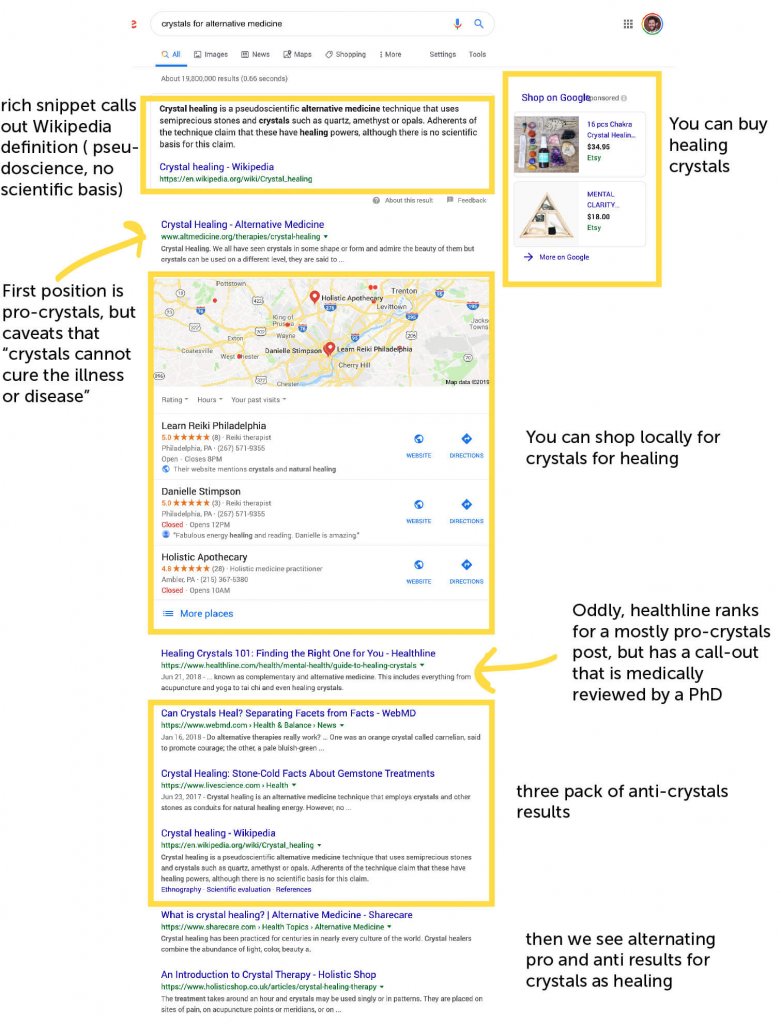
To be fair, most people think this example (crystals) is hocus pocus. BUT there is research-based evidence supporting its efficacy for people who believe in it and placebo effects are still just that, effects.
Maybe this seems like an outlier example, but there is a scale of what is considered accurate or factual and if you discuss important topics, you have to consider where your content falls on it:
- has either little to no scientific supporting evidence – this could mean
- established fields like cranial sacral therapy or cutting edge technologies, medicines, treatment approaches,
- newly repurposing existing approaches for new applications
- insufficient research exists because insufficient medical interest exists
- contradictory findings exist reducing the likelihood Google will serve your expert content over something like healthline or webmd
- inconsistent research results for some applications
- inconsistent research results for most applications
- shown to work but only under certain conditions with most evidence showing lack of efficacy for most conditions
- shown to work but…
- deemed to fall short of efficacy of alternatives
- considered inferior to more widely medically accepted alternatives
- potential demographic bias if not “Western” in origin
And we’re not talking about pure quackery here.
Any alternative medicine is going to fit on one of the above categories including:
- chiropractic and osteopathic medicine
- cranial sacral therapy
- meditation
- certain tools of physical therapy: TENS, traction, therapeutic massage
- massage therapy for chronic back pain
- acupressure, acupuncture
The point is that it’s all incredibly complex and Google is not yet sophisticated enough to account for that complexity, so it has to rely on signals that are likely overwhelmed by conventional thinking and what’s widely believed to be the status quo.
This is a concern for any innovative treatments. A breakthrough in any field could potentially see a longer time to acceptance or outright rejection due to old data signals.
Originally I thought this meant: if your subject matter is important, you need to back it up with data, real research, establish your authority through getting those research findings disseminated, and in general cultivating what we traditionally think of as authority in search (based on links).
But now primary research needs to be tempered with what’s considered factually accurate by the status quo.
Or, I guess, you need to start thinking hard about where else you’re going to get traffic from.
The problem here is that efficacy is situational. It’s a what-treatment-for-what-ailment with a comparison to alternatives with consideration to a series of factors: cost-effectiveness, time to result, side effects, allergies, likelihood of compliance, etc..
Funny enough, research has shown crystals to have a positive effect for healing… but only for those that believe in crystals for healing. This is widely attributed to the placebo effect.
I don’t believe in crystals for healing. But I do believe that rituals have an effect on well-being above and beyond what we think of as placebo.
Experimental research into placebo effects… suggests that ritual healing not only represents changes in affect, self-awareness and self-appraisal of behavioural capacities, but involves modulations of symptoms through neurobiological mechanisms.
Placebo studies and ritual theory, Kaptchuk (2011)
So this is pretty neat, and way off topic, but placebo studies are being used to inform ritual theory. Some takeaways from the above study:
- Biomedical treatment with powerful medications has a ritual component that is clinically significant.
- As with pharmaceuticals, each type of ritual, for example, fake needles versus fake pills, has a unique outcome.
- Components of rituals can be disaggregated and incrementally combined in a manner analogous to a dose response. For example, adjusting components of a ritual could make it more or less persuasive.
- Different healers can have different effects on patients even when they perform an identical prospectively defined precise scripted interaction.
